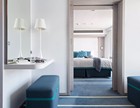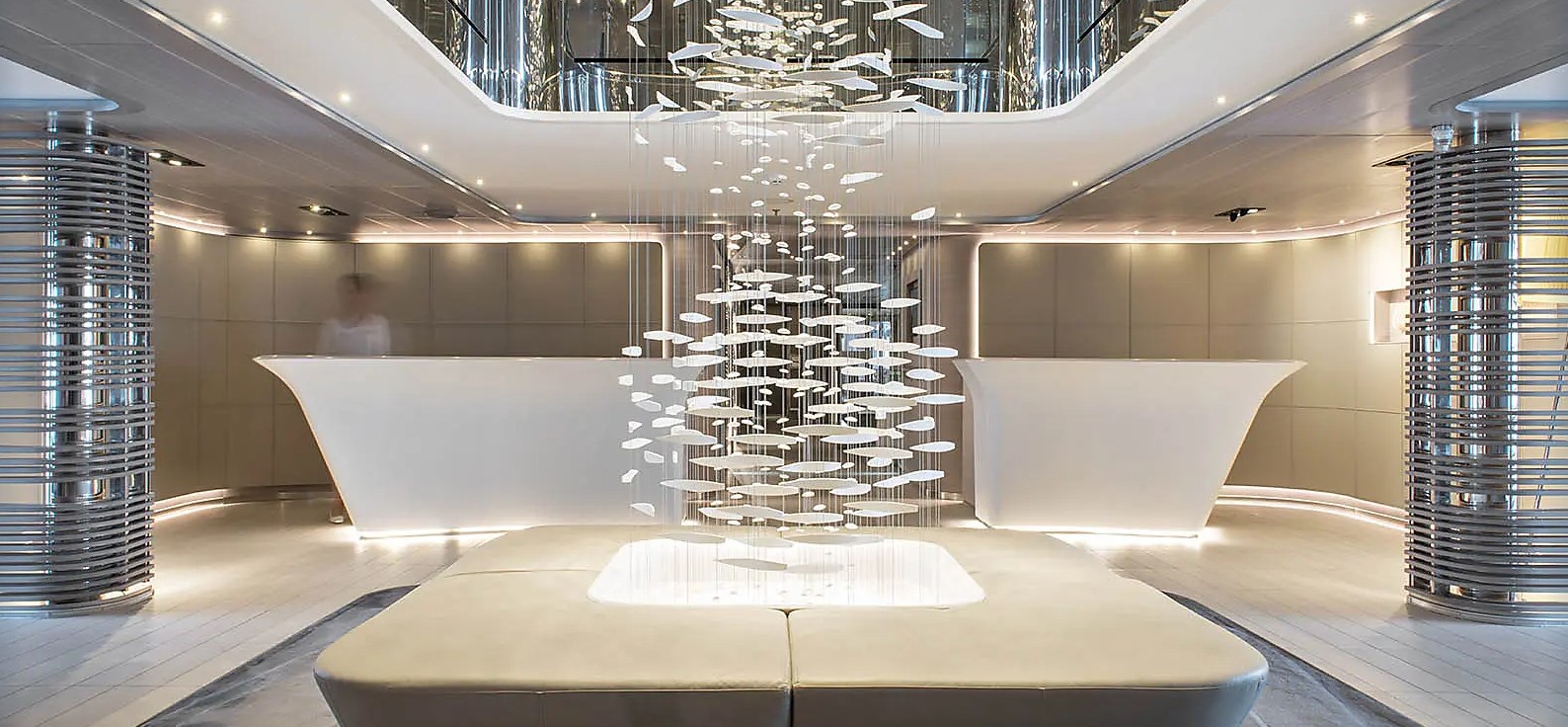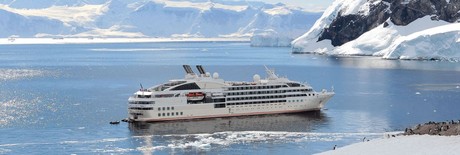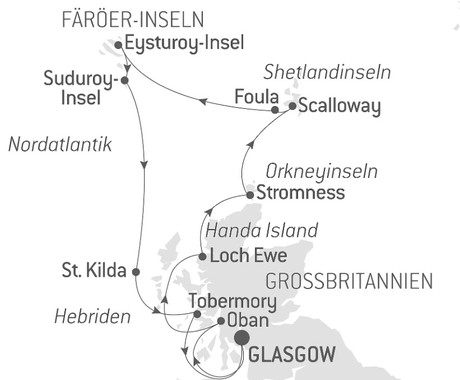Scottish Archipelagos & the Faroe Islands: Nordic Heritage & Island Identities
A 10-day expedition cruise aboard Le Bellot exploring the captivating landscapes and extraordinary historical heritage of the archipelagos of Scotland and the Faroe Islands, lands with Celtic and Viking influences.
Leaving from Fairlie, you will reach Fort William. This harbour town on the shores of Loch Linnhe is steeped in Scottish history and tradition, close to the beautiful and spectacular scenery of Glencoe.
You will then sail towards Loch Ewe in the Northwest Highlands, a sea loch that is home to a remarkable subtropical Eden; next, you will reach Shiant Islands and its huge sandstone cliffs, where many colonies of seabirds come to nest.
You will then head for the Orkney archipelago and its windswept moorland landscape. Stromness, a small fishing port with stone houses, reveals a rich history of Vikings, merchants and sailors.
In the middle of the North Sea, the Scottish archipelago of the Shetlands is rich in unsuspected treasures on its raw territories with jagged coastlines. From Scalloway, the stone structures at Jarlshof are a vibrant testimony to the first settlements while the cliff at Sumburgh Head offers fantastic views of the seabirds. On the more remote island of Foula, man has had to deal with the elements.
Your ship will then sail north towards the the Faroe Islands, Denmark’s northernmost autonomous territory. In this isolated archipelago, you will immerse yourself in a wild and spectacular natural environment. In Suduroy, the rolling plains populated by sheep shape the scenery punctuated by sheer summits, mountain lakes and jagged cliffs looking out to the islands, offering outstanding terrestrial and maritime panoramas. In Streymoy, you will enjoy sailing around cliffs home to bird colonies. Here, the Viking legends and the Nordic cosmogony are never far away.
In the Hebrides, St Kilda is a small volcanic archipelago with incredibly beautiful scenery, where the sheer cliffs rub shoulders with vast and verdant relief. The main island is a UNESCO World Heritage Site; uninhabited since 1930, it has remnants of very old dwellings.
The last stage of your journey will take you to Tobermory, a charming fishing port with multicoloured houses and with a distillery that produces a renowned single malt, before you arrive in Glasgow, your disembarkation port.
In the heart of the Clyde Valley, the bustling city of Glasgow contrasts starkly with the wild beauty of the surrounding countryside. Scotland's biggest city overflows with landmarks from its extensive artistic heritage and outstanding architectural tradition. The city's chequerboard layout makes walking through the major pedestrian thoroughfares easy: go with the flow and let the lively street atmosphere take you past the many Victorian monuments. Don't miss the collections on display in the numerous museums and art galleries. The Kelvingrove Art Gallery and Museum is an outstanding example.
A port town on the eastern shore of Loch Linnhe, Fort William is sometimes described as the "Outdoor Capital of the UK." Because it sits at the base of Ben Nevis, the highest peak in the British Isles, and is in close proximity to the dramatic landscape of Glencoe, it is a popular destination for hikers and rock climbers. For those looking for a less adventurous experience, the nearby Ben Nevis Distillery offers tours and tastings, and Old Fort and Old Inverlochy Castle are interesting historical sites.
Loch Ewe, located in the Northwest Highlands, is a sea loch surrounded by mountains, looking out onto the North Atlantic. It was an assembly point for maritime trade in the past and military ships used to gather there during the Second World War to organise safe convoys to the Arctic. On its shores, the loch shelters a remarkable botanic garden, Inverewe Garden, whose many hundreds of tropical plants and species prosper thanks to the Gulf Stream. Protected from the violent winds by endemic pine trees, the garden, which was created in 1862 by landowner Osgood Mackenzie and his daughter Mairi Sawyer, will unveil unsuspected colours, shapes and perfumes. It is now managed by the National Trust for Scotland. Perhaps you will be lucky enough to glimpse some of Scotland’s wild animals: red squirrels, red deer, otters, seals or golden eagles. To the far north-west of Scotland, Handa is a small wild island, very close to the Highlands, that you will discover by sailing along its magnificent cliffs of Torridonian sandstone (a grey or dark red Precambrian rock), which are some of the oldest in the British Isles. Each summer, they shelter large colonies of seabirds for the breeding season, such as razorbills, puffins, great skuas and Great Britain’s largest population of common murres. You will perhaps have the possibility of observing marine mammals living in the fish-rich waters surrounding Handa.
The stone houses stand proudly facing the sea in the charming town of Stromness, the second most populous town in Scotland’s Orkney Islands. Long ago called Hamnavoe – meaning “safe harbour” – because of the safety it provided to Viking travellers, sailors and merchants sailing around Great Britain, the town has retained its gentle way of life. Strolling along its picturesque streets will immerse you in the history of the fishermen and whale hunters, but also allow you to discover a lively town with a living culture.
On the Atlantic seaboard of the Mainland, Scalloway is a fishing port and the former capital of the Shetland archipelago, a wild territory with windswept jagged coastlines, located off the coast of Northern Scotland. In the 16th century, the Earl of Orkney, Patrick Stewart, had his residence forcibly built there, a castle whose ruins are still visible and which came to symbolise “Black Patie’s” oppressive rule over the Shetlander people. At the far south of the island, the internationally renowned archaeological site of Jarlshof reveals a striking historical snapshot of settlement in the Scottish Far North, from the Iron Age to the Pictish and Viking periods. You will then discover Sumburgh Head, a rocky outcrop topped by a lighthouse; this site is the kingdom of Atlantic puffins and gannets, and is unmissable for birdwatchers! Foula, lying some twenty nautical miles west of the Shetlands, is the archipelago’s most remote island as well as one of the most remote inhabited British islands: it only has thirty inhabitants, who still observe the Julian calendar, introduced by Julius Caesar in 46 BC. The island rock measures 12.5 km2 (4.8 square miles) and is characterised by its high cliffs, the largest of which reach 365 m (almost 1,200 feet). Inland, there are farms in the heart of huge expanses of moors and peat bogs where flocks of sheep and herds of ponies live in total freedom. The Vikings were the first explorers to come here and they named it Fugløy or “bird island”. You will be able to explore these green windswept landscapes, to the cliffs of Hiora Wick and Gaada Stack, home to nesting colonies of seabirds, including fulmars, Atlantic puffins and eiders.
Suduroy Island, literally “South Island”, has one of the smallest populations in the Faroe Islands. It has sheer cliffs along its western face. The island is an important breeding ground for seabirds, including northern fulmars, black-legged kittiwakes, Atlantic puffins, and guillemots. Your expedition team will guide you as you discover the island, its authentic villages with black, tarred-wood churches typical of the Faroe Islands, and its hiking trails lined with peat fields and stone sheepfolds. Sheep are indeed omnipresent throughout the Faroe Islands — in fact, there are more sheep than humans —, and they add to the charm of these wild landscapes.
Streymoy Island is the largest and most populated of the Faroe Islands, with 22,500 inhabitants. Lying between Scotland and Iceland, the 18-island Danish archipelago boasts natural wonders that will fascinate lovers of the great outdoors. Here, the hilly green landscapes stand in contrast with the huge basalt cliffs and the invigorating air shifts with the moods of the ocean. To the north, the small village of Saksun, with its traditional grass-covered rooftops, has 14 inhabitants. In the curve of a magnificent natural amphitheatre, it overlooks a fjord with a lagoon: an idyllic setting in a secluded and peaceful environment. To the west, in Vestmanna, myriad birds nest in the crags along the eroded and vertiginous cliff faces.
St Kilda is an archipelago of seven volcanic islands, located 35 nautical miles west of the Outer Hebrides. They are the most remote of the British Isles. It is the only site in the United Kingdom to hold joint UNESCO World Heritage Site status for both its natural and cultural qualities. St Kilda has been managed by the National Trust for Scotland since 1957. According to the vestiges discovered there, the first travellers to the island appear to date back to the Bronze Age. For 2,000 years, a small community of inhabitants survived there, economically self-sufficient, until the last ones left in 1930. The village was organised around blackhouses, typical of the Hebrides, cultivable plots and cleitean, dry stone foodstuff storage huts, scattered across the archipelago. The endemic Soay sheep live wild, while the archipelago’s impressive cliffs shelter colonies of Atlantic puffins and gannets.
Located at the northernmost tip of the lovely Isle of Mull, Tobermory has to be one of the most beautiful natural seaports on Scotland’s West Coast. Founded in 1788, this ancient fishing village has been converted to a leisure port highly appreciated today for its surroundings and the quiet charm it exudes. You will definitely be won over by the row of many-storied houses on the hillside, illuminating the harbour with their vibrant colours. Although the real spectacle is outdoors, no less interesting are the Mull Museum dedicated the local history and the exhibitions at the An Tobar art gallery.
In the heart of the Clyde Valley, the bustling city of Glasgow contrasts starkly with the wild beauty of the surrounding countryside. Scotland's biggest city overflows with landmarks from its extensive artistic heritage and outstanding architectural tradition. The city's chequerboard layout makes walking through the major pedestrian thoroughfares easy: go with the flow and let the lively street atmosphere take you past the many Victorian monuments. Don't miss the collections on display in the numerous museums and art galleries. The Kelvingrove Art Gallery and Museum is an outstanding example.
Itineraries are subject to change.
|
Book now |
Superior Stateroom

Deluxe Stateroom

Prestige Deck 4

Prestige Deck 5

Prestige Deck 6

Deluxe Suite

Prestige Deck 5 Suite

Privilège Suite

Grand Deluxe Suite

Grand Privilege Suite

Additional charges:
Port fees and taxes: $670 AUD
Vessel Type: Luxury Small Ship
Length: 142 metres
Passenger Capacity: 224
Launched: 2015
A sleek silhouette, a welcoming intimate atmosphere, discover aboard this new ship the philosophy that has made our sisterships such a success: the spirit of Yacht Cruises.
Sailing under the French flag, this magnificent yacht of only 122 staterooms and Suites, with balconies, will join our fleet in April 2015. You will be enchanted by the contemporary decor inspired by the our destinations and the blue light of the Vega star in the Lyra constellation. The result is a subtle variation around a palette of blues, ranging from the luminous delicate grey-blue of the Polar ice to splashes of the vivid turquoise blue found in Mediterranean coves
A refined ambiance is enhanced by the quality of the workmanship and materials: white Corian counters in the lobby contrast with the warmth of leather to recall a boat’s hull, while the central sculpture of enamelled pieces takes its inspiration from the sea. In the loungebar, the carpet picks up a tennis stripe theme symbolising a certain idea of cruising, one synonymous with French elegance and a chic seaside spirit.






Special Offers
Online prices reflect the current brochure fare savings of up to 30%. Prices may change based on demand. Terms and conditions apply. This special offer is subject to availability. Please contact us for more details.
Inclusions
• Accommodation in stateroom
• The full meal plan
• The Open Bar: beginning with boarding, and during the duration of the cruise, a wide selection of drinks (mineral water, soft drinks, wine, beer, champagne, spirits, coffee, tea) is served on request and at any time of the day. Certain premium alcoholic beverages on the menu are not included in the Open Bar
• Free Wi-Fi internet access 24 hours a day*
• Activities offered during expedition cruises (see section "Expedition cruises")
• Access to all the common areas on board our sister ships and Ponant Explorers: fitness room, steam room, hair salon, swimming pool (sea water, heated), solarium, lounges, theater, boutique & leisure area
Exclusions
• Flights other than those mentioned in the itinerary
• Travel insurance
• Passport and visa costs if applicable
• Premium beverages package (Can be purchased on board)
• Optional Excursions where applicable
• Spa treatments on board
• Pre and post cruise accommodation unless otherwise stated
• Transfers unless specified
• Gratuities
Highlights
• An all-new expedition cruise discovering the subarctic archipelagos of Scotland and the Faroe Islands, remote territories of volcanic origin, renowned for their dramatic scenery and their singular identities, between Celtic and Viking heritage.• Outings and shore visits with an experienced team of naturalist-guides.
• Hiking opportunities.
• UNESCO World Heritage Sites: the Heart of Neolithic Orkney (Skara Brae and Brodgar Circle), Saint Kilda.
• Five new port of calls: Oban, Loch Ewe, Scalloway, Foula, Saint Kilda.
• At Loch Ewe, the visit of the Inverewe Garden, a remarkable collection of shrubs and exotic plants.
• Discovering archaeological sites dating back to the Neolithic period, striking testimonies to the ancient settlements of these archipelagos.
• An all-new cruise around Handa Island and its bird cliffs.
• Exploration of the Faroe Islands, the northernmost autonomous territory of Denmark, from stunning natural landscapes and traditional Faroese villages.
• Scenery: volcanic islands, jagged coastlines, lochs, heather moorlands, peat fields, sandstone cliffs, lush
valleys.
• Wildlife : gannet, crested cormorant, fulmar, eider, puffin, golden eagle, red squirrel, red deer, seal, otter, sheep.
Our Associates Include














